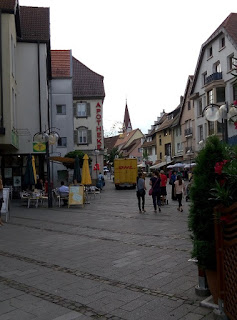Plochingen
Please note that the configuration of Old Town Plochingen,
which is the center of the town because it is not that big, follows Old Town
Frankfurt's model: cobblestoned roads/walkways, government buildings close to
the church, which dominates all.
The red building in the foreground is currently the library;
the white building with red beams is now a museum whose first incarnation was
in fact the seat of government for that small town. Centuries later, this
larger Rathaus (government building) was built and serves in that function
still today.
I remember reading somewhere about a law that, in Europe, no
building is to sit higher than the church, for 2 reasons. 1: the church is the
most important building in any community, and 2: no building other than the
Church should be closer to God or aspire to the heavens. To that end, the
church was usually built on the tallest parcel of land: a hill or high above
the riverbank. The spire serves to 'reach God' as well as announce its location
on the landscape.
If I remembered that correctly, the theory bears out: riding
across German countryside on trains, the highest point and most visible icon in
any town was indeed the church spire. This new Rathaus in Plochingen broke that
tradition, being situated on a hill above the church and sitting higher than
the church's spire.
Plochingen's older street was indeed cobblestoned; in fact
it was more a pedestrian street because deliveries were only permitted before
8AM. I happened to be there around that time, and this is what it looked like:
It's sister street, more modern (and less cobbled) but no
less frequented
That is pretty much the essence of Plochingen, unless you
want to venture into the more mundane concerns such as schools, grocery stores
and the train station – a rather bland building, by comparison to those shown
here.
Sitting in the town square, enjoying the free WIFI provided
by the church (I'm not joking!), suddenly the clarion chimed 10 o'clock. This
charming building plays a glockenspiel (glocke = bell; spiel = play) every
hour.
After enjoying it, I moved on.
Esslingen
whereas the feel of Plochingen was provincial, Esslingen
felt like a suburb of a major city. Could well be because that's what it is.
Stuttgart, the region's metropolis, is only 2 train stops away. Many people
commute to the city (judging by the crowds on the S-Bahn commuter train), but
prefer the slower pace this charmer of a town offers.
As with the other cities described, Old Town Esslingen centers
around the church, and there is a cobblestoned pedestrian street.
A distinct difference from the other places described is the
country's oldest Sekt Keller (sparkling wine 'basement' – not a basement but a
whole building, dominating the town square, directly across from the church):
You might wonder about riding a bike on those cobblestones.
It is not exactly a pleasant feeling: you'll note the rider is not sitting on
the seat. However, I aver that Germans overwhelmingly love riding bikes! Bikes
are allowed on trains, streetcars and trolleys. There are distinct bike riding
lanes and even traffic lights especially for bikes. A refreshing change from
risking life and limb, riding in China!
Beyond the church and the Sekt Keller, Esslingen boasts many
unique architectural jewels:
The Inverted House (not its official name): each successive
layer is bigger than the one underneath, but only on 3 sides.
The Melting House (again, my imagination takes flight!)
seems to be sloughing off to the west.
What appears to be the last tower of the old city wall,
ignobly reduced to being an ice cream store.
There's actually quite a bit to see in Esslingen – like: the
water wheels, still in use and generating electricity for that portion of the
city. But my favorite had to be the coffee store, because you could put a coin
in the slot and pull out a drawer of your select coffee!
Two more things about Esslingen:
1.
'Ess' = 'eat' in German. Thus it became the
running joke during my visit with Olaf and his family that, after exploring
Esslingen, we should go to Trinklingen – 'trink' meaning 'drink'.
2.
Looking up pays off, yet again! High above the
mundane rooftops, nowhere near the Sekt Keller or any other remarkable
building, I spotted this pass-through, presumably leading from the government
building to the church's spire. Too bad we didn't have time to explore it!
Plochingen, Altbach – nothing more than a wide space in the
road where my friend lives, Esslingen, Stuttgart: all in a row, now all
explored. We didn't get to see very much of Stuttgart because it was time to
move on to Berlin. Oh, well! The Stutt, as I affectionately refer to that city,
will have to wait till next time!
On to the most anticipated leg of this trip: my old stomping
grounds, Berlin.
But before that...












No comments:
Post a Comment